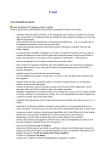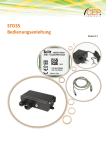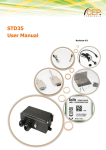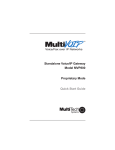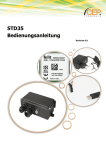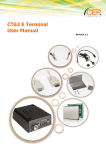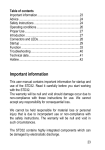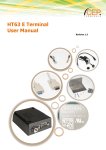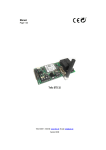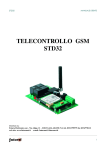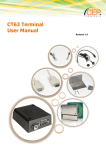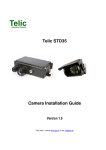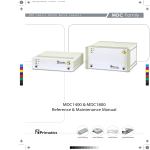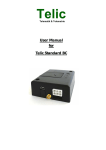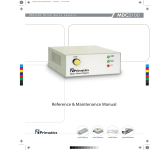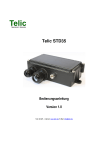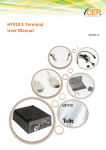Download STD35 Telemetry module User Manual
Transcript
STD35 Telemetry module User Manual Table of contents Subjects Important Information Advice Safety instructions Operation conditions Proper use Introduction Connectors and LEDs Startup General aspects Configuration call Usage Tracking via GPS Modem functionality Trouble shooting Technical data Page 1 1 1 2 2 2 3 3 4 4 4 7 8 8 9 Important Information This user manual contains important information for startup and use of the STD35. Read it carefully before you start working with the STD35. The warranty will be null and void should damage occur due to non-compliance with these instructions for use. We cannot accept any responsibility for consequential loss. We cannot be held responsible for material loss or personal injury that is due to incompetent use or noncompliance with the safety instructions. The warranty will be null and void in such circumstances. The STD35 contains highly integrated components which can be damaged by electrostatic discharge. Therefore only touch the STD35 on the edges and avoid to touch the pins of components on the board. Advice The one who makes the module operational by adding further components or putting it into a housing, is seen as manufacturer according to DIN VDE 0869 and obliged to hand out all necessary documents with the device and to indicate his name and address. Devices which are made out of modules have to be considered as an industrial product from the safety perspective. During use of the STD35 Short Messages (SMS) can be generated automatically. Costs may occur for you by this SMS traffic. Safety Instructions When using products which are exposed to electric voltage the valid VDE-regulations have to be observed. Especially VDE 0100, VDE 0550/0551, VDE 0700, VDE 0711 and VDE 0860 are applicable. • Before opening of a device always pull the mains adapter or make sure that the device is disconnected from the power supply. • Components, modules or devices have to be build into a housing before they are put into operation. During installation they should not be connected to any power supply . • You should only use tools on components, modules or devices if they are disconnected from the power supply and the electric charge, which may still be stored in some components, inside the device has been discharged. • All cables and wires which are energized and connected to the device, the module or components have to be checked regularly for any damage of the isolation shield or fractures of the cables. If the supply cables are visibly damaged the device has to be taken out of operation immediately until the faulty cable has been exchanged. 1 • When using components or modules it is necessary to strictly observe the specification given in the corresponding description of these components. • If a description for a private end-customer not clearly states which electric data is valid for a component or a module, how to wire the device, which external components or additional devices can be connected or which parameters these components are allowed to have, a specialist must be contacted. • Before putting a device into operation, it has to be clarified, whether this device or module is meant for the field of application. In case of doubt ask specialists or the manufacturer of the device. • Please note that we are not responsible for any errors in usage or connection. Therefore we cannot accept any responsibility for consequential loss. • Devices which operate with >35 Volt have to be connected by a specialist. • Before putting the device into operation it should be checked that there is no current leakage on the housing. • In case that measurements with the opened housing are necessary, an isolating-transformer has to be integrated for saftey reasons. Alternatively the voltage can be supplied by an appropriate power supply which complies with the safety regulations. All wiring work has to be done in a voltage free state only. Operating conditions • Operate the STD35 only with a supply voltage between 5-32V and have in mind the polarity! (see picture1) The power supply has to deliver at least 500mA. If you use a mains adapter for power supply it has to be conform with the VDE regulations. • Devices with an operating voltage >35 Volt have to be installed by a specialist observing the VDE regulations. • Loads connected to the device are not allowed to exceed 1000W per relay. • The maximum voltage is 250V AC (alternating current) • The maximum switching power per relay is 6A (depending on the width of the PCB tracks) • No special operation position of the device has to be observed. • When installing the device make sure that the supply cable has a sufficient diameter • During operation the temperature has to be between -20° and 55° Celsius. • In case of condensation allow a period of about 2 hours for acclimatisation. • Keep away the device from flower vases, bath tubs, washbasins, liquids etc. • The device is meant for operation in dry and clean rooms. • Protect the device from humidity, spray water and heat. • Do not expose the device to heavy vibrations. • Do not operate the device in areas where are or could be inflammable gas, vapours or dust. • The unit may only be repaired by a specialist. • Only original parts have to be used when repairing the unit. The use of differing spare parts can cause serious material loss or personal injury. Proper Use The device is designed for the remote switching of devices via the GSM network as well as the remote retrieval of status information of the inputs and the generation of SMS messages after status has changed at the inputs. A different utilisation of the device other than the one described above is not allowed. Introduction The STD35 is a telemetry module which is easy to install and simple to use. With the STD35 you can control five relays and monitor the status of five digital inputs with one or several common mobile phones. Apart from the STD35 you only need a valid SIM Card of any network provider (GSM 900 / 1800 MHz). While using prepaid SIM-cards one shall always keep himself aware of the amount left on the card, so that in case of alarms a SMS could be sent. Typical fields of application are the opening of (garage) doors, switching on and off light and alarm devices as well as generating alarm messages (SMS) or the retrieval of information from door sensors, movement sensors or level sensors etc. 2 Connectors and LEDs Connection Scheme of the 12V DC Voltage Supply Figure 1 As described in figure 1, the STD35 has 6 screw terminals for the digital inputs and 6 screw terminals for the Relay outputs. Screw terminal 1 is the common negative reference point for all 5 digital Inputs. The terminals 2 to 5 are the positive reference points for the after coming opto couplers. On the output side are further 6 screw terminals, from which the terminal 12 represents the common reference point and switching potential for all 5 relays. On the PWR the power supply of the STD35 will be connected. On the connection ANT the GSM antenna is to screwed in (connector type FME). When the module is booked into the GSM network, the green GSM LED is blinking at the front side about once within 2 seconds. The LEDs „Input-Event“ and „Output-Event“ signalize the Status of the inputs and outputs. The LED „Output-Event“ blinks shortly, when one of the 5 relays is activated, the LED „Input-Event“, when one of the 5 inputs is controlled. Please take into account the maximum switching current of the relays and the maximum input current and voltage of the Opto couplers! In the chapter „Startup“ you will find further information for it! Startup: For the installation of the STD35 you need a released SIM card of a GSM network provider, on which the PIN has been put to „0000“. To change the PIN accordingly, you can use a regular mobile phone. Please get the proceeding for Pin change out of the corresponding user manual of your mobile phone. In case of using a SIM card with another PIN than „0000“, the STD35 will use a „wrong“ PIN during each power-on, which leads to blocking of the SIM card after the 3rd trial . When this happens, you have to assign a new PIN number using the Super-PIN (PUK). Please get related advice for the change of PIN number and reset of blocked PIN number with the PUK out of the user manual of your mobile phone. In case your want to use a SIM-Karte without PIN, this is possible as well; the STD35 recognizes this and is running accordingly. Before connecting the supply voltage, please enter the SIM card into the SIM-card holder on the rear side of the STD35. Displace the moving part of the SIM card holder a little bit and open it. Enter the SIM card into the moving part, close it again and fix it by slight displacing. Please consider the position of the SIM card, especially the position of the flat corner. If not yet done, please connect and tighten the GSM antenna. After that, please establish the connection to the supply voltage. The GSM-LED, shortly after, begins to shine steadily. The STD35 will try now automatically, to book into the GSM network. As soon as the STD35 is booked into the GSM network, the GSM-LED once for around all 2 seconds. 3 General aspects: Your STD35 can basically be configured in 2 ways: 1. Configuration-Call („easy-setup“) In factory status the STD35 can be configured by a call within the first 3 minutes after connecting to the supply voltage. In this case is „logging“ the phone number, from which this call has been made (supposing, that this number is transmitted), and will report future event to this phone number. You can switch by a call from this phone, from now on known to the STD35, also one of the relays. The total STD35 can so be configured by call, in which it is remembering the phone number, for simple applications. You don’t need a PC for it and don’t need to send SMS neither. 2. Configuration via SMS („professional setup“) For more complexe tasks, e.g. the switching of the 5 outputs, the configuration of several persons being authorized to switch or get event messages, the modification of the standard texts and a number of further parameters the STD35 via SMS configured and controlled in a very flexible way. Even the Reset into the factory status, e.g. to proceed for y new configuration call, is possible. The configuration via SMS is described under „SMS commands“. Configuration-Call Please wait, until the GSM-LED has started to blink. Then please call with the mobile phone, which is assigned to control the STD35, the phone number of the SIM card being inside of the STD35. The call will be accepted by the STD35 and will be terminated a couple of seconds later. As a control sign five signal tones will be sent via DTMF sequences! They can be heard during this call on your mobile phone. Due to this call the STD35 will be adjusted to the corresponding mobile phone, it will „log“ Your phone number, that has been transmitted. Therefore please take care, that your mobile phone will transmit the phone number, means the GSM function „incognito“ or „private call“ has to be switched off. This is a configuration, that you can settle on your mobile phone, in which you put in the SIM card. (For testing this feature you can call another mobile phone, there your phone number or name have to be displayed) In case the STD35 e.g. due to being separated from the supply voltage, the STD35 will send, after the reapparition of the supply voltage, automatically an SMS with the content „START-UP ALARM“ being sent to the configured phone number. Please consider: When the STD35 is not confirgured in factory status (neither by configurations call nor by SMS), it will show this by alternative blinking of the LEDs „Input-Event“ and „Output-Event“. It is switching off after 3 minutes autonomously, when not being configured within this time slot. A renewed connecting to the power supply will switch on the STD35 anew, and it is expecting again a configuration. Usage After being configured, the following functions of the STD35 will be at your disposition: Switching per call Please call, after made configuration, the phone number of the SIM card being inside of the STD35. Please take care, that your mobile phone is transmitting the phone number. (see as well „configuration call“). The relay 1 will then, depending on the configuration, switch for a certain time (factory status: 1 sec). The relays-status-LED „Output-Event“ is on during this period. Launch an Alarm SMS Put for 1 second (Factory configuration) a voltage of 12V at one of the inputs, consider the polarization! Then an alarm SMS will be sent to your mobile phone. The LED „input event“ is shortly flashing-up, when you put the voltage to the STD35. Sending SMS commands Your STD35 can launch switching processes as well as be configured via an SMS, that you send to it. The Format of the Configuration SMS: To protect your STD35 against not authorized access, each of the configuration SMS to the STD35 has to begin with a 4 digit password. The factory default provides the last 4 digits of the IMEI number for it! Your IMEI number is visible on the GSM module: 4 The last 4 digits of the IMEI are therefore the password for your device and should be kept secretly from your side. The IMEI number cannot be changed! You can also change the password for security relevant cases, but please bare in mind that each command – also the reset to the factory status- will presumes the knowledge of this password. Control Commands via SMS: Control commands via SMS will only be executed, if the phone number of the sender has been communicated to the STD35 before. Control commands don’t need a password. All command (with exception of R: and ST?) have to be terminated with a dot! All commands can be sent in one SMS, separated one from the other by the terminating dot. The indications of the seconds can have 1-5 digits. Valid indications are e.g.: 1 or 90 or 99999, that means there won’t be put leading Zeros before the digits (e.g. “O1:90”. This is euiqvalent of 90 seconds). Please pay attention to the difference between the number 0 and the letter O! (“O1ON.” Contains two times the letter O, whereas “O1:0” contains once the letter O and once the number 0). Basic functions • After having been called from the assigned („stored“, pls. See configuration call) mobile phone, the relay 1 switches for a second. • When the digital input1 will be activated for a second, the STD35 sends a SMS with the content „EVENT ALARM 1“ to the assigned mobile phone. • When the digital input2 will be activated for a second, the STD35 sends a SMS with the content „EVENT ALARM 2“ to the assigned mobile phone. • The same is certainly valid for the inputs 3 to 5. Switching via SMS • After having received a SMS with the content „O1ON.“ (=Output 1 ON) from the assigned mobile phone, the relay 1 will switch for a second. In case of a SMS “O2ON.” The relay 2 will switch for a second. • The same is certainly valid as well for the outputs “relay 3 to relay 5”. • In the case that the switching time has been put to 0 (number 0), the relays switch permanently to the other status. Configuration SMS • The configuration SMS is valid, only if beginning with the 4 digit password. Teh CLIP of each of the configuration SMS will, if the password is correct, be logged automatically as a new administrator. Therefore it has to be considered, that the configuration only is executed from the mobile phone of the administrator. • With a SMS having the content „O1:xxxxx.“ (character O= (xxxxx = seconds) the switching times of the relays can be configured. The STD35 will keep these configurations even after the cut-off from the supply voltage. • In case that the switching time for a relay has been put to 0, the STD35 will, at each new call, switch the related relay permanently. Has the relay been active before, it will go to inactive and vice versa. In this case also a SMS containing “O1ON.” from the assigned mobile phone will switch the relay 1 on permanently. A SMS with the content “O1OFF.” will then switch the relay 1 again off permanently. Accordingly the relays 2 to 5 will react on SMS messages which contain “OxON.” And “OxOFF.” (x=2...5). • By a SMS with the content e.g. “I1:xxx.” (xxx=seconds) the times can be programmed for the five inputs, during which these inputs have to be active, before the STD35 will send out an alarm SMS. The inputs 2 to 5 show the identical behavior. • By a SMS with the content e.g. “V1:x.” Or “V2:x.” (x = 1 oder 0) the polarity of the inputs can be inverted. In case of x=1 there will be sent a alarm SMS, if the input was deactivated longer then the configured time. For the inputs 3 to 5 equivalent proceeding is valid (e.g. V4:x.). 5 • Using the SMS „S:x.“ (x = 1 or 0) the Start SMS (START-UP ALARM) can be switched-on or –off. • The SMS „R:“ will set back the device into the factory status. • Via the SMS „ST?“ you can ask for a response SMS from the STD35 with the actual status of the inputs and outputs. The same functionality can be achieved pushing the button on the upper side of the STD35, being under the LED. Please consider, that each of the pushings will lead to the sending of a SMS and so will create costs for you. • With the SMS, e.g. for the outputs 1 and 2, “A1:xxx.” Or “A2:xxx.” (x = seconds) you can adjust the delay, after which, after a switching, the status will be sent in the response SMS. This ist e.g. very helpful, if you launch a switching and you measure the result of the switching on an input of the STD35. Using this, the changed status after the switching will be signalized. For the outputs 3 to 5 the same behavior will happen. • The command „PN:<4digit password>.“. will change the password. The password can consist in 4 freely chosen numbers or character combinations, special signs are not allowed. Characters within the password have to be written in capital letters. In factory status the password is always the last 4 digits of the IMEI, see also chapter “ SMS commands”. • You can define up to four further alarm numbers (master numbers C2:-C5:), to which also Start and Event SMS will be sent. These numbers can also switch the relay 1 by call and can execute other control commands via SMS. Configuration SMS though can only be sent successfully from the administrator’s side. If the alarm numbers are entered in international format, they have to start with a „+“• You can give authorization to up to one hundred of further phone numbers to switch the relay 1 by call. To do so, you have to build up the “extended Clip” list respectively you have to enter phone numbers into this Clip list. You can also, using “CD:”, erase again phone numbers within this list. • The texts for Event respectively Start-up messages can be modified using the commands E1:<text1>.,E2:text2>. Up to E5:<text5>. And PT:<startup-text>. Within the texts no SMS command for configuration is allowed and the final dot is terminating the text. Each text message can have up to max. 64 characters. Each text input has to be done in a separate SMS. Table of SMS Commands Factory settings Status of I/Os Start SMS on/off Relay 1 on Relay 1 off Relay 2 on Relay 2 off Relay 3 on Relay 3 off Relay 4 on Relay 4 off Relay 5 on Relay 5 off Switching time Relay 1 R: ST? S:1. / S:0. O1ON. O1OFF. O2ON. O2OFF. O3ON. O3OFF. O4ON. O4OFF. O5ON. O5OFF. O1:xxxxx. (Seconds) Switching time Relay 2 Switching time Relay 3 Switching time Relay 4 Switching time Relay 5 Delay before reply Relay 1 Delay before reply Relay 2 Delay before reply Relay 3 Delay before reply Relay 4 Delay before reply Relay 5 Time of activation Input 1 Time of activation Input 2 Time of activation Input 3 Time of activation Input 4 Time of activation Input 5 Invert Input 1 Invert Input 2 Invert Input 3 Invert Input 4 Invert Input 5 2. Alarm number O2:xxxxx. (Seconds) O3:xxxxx. Seconds) O4:xxxxx. (Seconds) O5:xxxxx. (Seconds) A1:xxx. (Seconds) A2:xxx. (Seconds) A3:xxx. (Seconds) A4:xxx. (Seconds) A5:xxx. (Seconds) I1:xxx. (Seconds) I2:xxx. Seconds) I3:xxx. (Seconds) I4:xxx. (Seconds) I5:xxx. (Seconds) V1:x. (x= 1/0 ) V2:x. (x= 1/0 ) V3:x. (x= 1/0 ) V4:x. (x= 1/0 ) V5:x. (x= 1/0 ) C2:<number>. 6 3. Alarm number 4. Alarm number 5. Alarm number New Password Event Text 1 Event Text 2 Event Text 3 Event Text 4 Event Text 5 Start Up Text Add Clip to the extended Cliplist Remove Clip from the extended Cliplist C3:<number>. C4:<number>. C5:<number>. PN:<4digit password>. E1:<text>. E2:<text>. E3:<text>. E4:<text>. E5:<text>. PT:<text>. CL:<nummer>. CD:<nummer>. Examples for SMS Commands Configuration using control command: Start message Off, Relay 1 On, Relais 2 Off, Time of activation of input 1: 5 sec.: 2759 S:0.O1ON.O2OFF.I1:5. The sender of this SMS is from now on Administrator Configuration: Switching time of Relay 1 = 90 Sekunden: Configuration: Reset to factory settings: Configuration of a 2nd Alarm number: Erasing of an Alarm number 2759 O1:90. 2759 R: 2759 C2:+491721234567. 2759 C2:. Configuration of a new password: 2759 PN:AB12. New Number in extenden Clip list: 2759 CL:+491721234567. Remove Number from extended Clip list: 2759 CD:+491721234567. Control commands O1ON O2OFF O3ON Tracking via GPS By plugging of an appropriate GPS Mouse on the serial connector (DSUB 9) of the front side of the STD35, you can transmit the GPS data directly to your mobile phone. This function can be launched from the Admin respectively the 4 additional Masters durchgeführt werden. The users, who are in the extended Cliplist, can Not use this function! To ask for actual position of your STD35, please use the following SMS commands: GPS? After reception of this SMS the STD35 sends a SMS with the following text to your mobile phone: $GPGGA,<1>,<2>,<3>,<4>,<5>,<6>,<7>,<8>,<9>,M, $GPGGA,083537.00,4802.00364,N,01135.21171,E,1,4,7.95,579.8,M,47.5,M,,*61 1 UTC time 2 Latitude 3 Hemisphere 4 Longitude 5 Hemisphere 6 Position fix 7 Number of Satellites 8 horizontal Precision 9 Height over sea level Unit of height hh=08;mm=35;ss=37.00 corresp. 09:35:37 MEZ Latitude: 48 Degrees; 02.00364 Minutes N nordic Latitude Longitude: 11 Degrees; 35,21171 Minutes E eastern Longitude 0 No fix; 1 GPS SPS mode; 2 DGPS mode; 3 GPS PPS mode 4 Satellites used for Position Precision of the Position: 7,95 Meters 579.8 Meters M for meters 7 10 Age of the GPS Data here No DGPS used A GPS tracking can also be asked by call. This function however is only possible for the Admin and the 4 futher Masters. For being able to use this function, the default status (call switches relay 1) has to be changed by the Admin. This is done from the Admin’s side sending a SMS with the following content: 2759 G1:x. x=0 Calls from Admin and the Masters switch Relay 1 (factory setting) x=1 Calls from Admin or the 4 Masters launch a tracking request; for which the reply will be sent back exclusively to the number having called. For the possible 90 Users on the extended Cliplist it is still possible to switch the relay 1 by call, even though the command <2759 G1:1> has been sent from the Admin’s side. Please consider, that for the connection of GPS mouse probably a Zero-Modem adaptor has to be put between the RS232 connector of the STD35 and the GPS mouse. Modification of the Baudrate for different GPS-Mouses: Since GPS-Mouses from different manufacturers work with different baudrates, the baudrate of the STD35 can be put to 9600 Baud and 4800 Baud. Therefore the following configuration command has to be sent to the STD35: 2759 BR:x. x=0 x=1 Baudrate 9600 (Factory setting) Baudrate 4800 Baud Modem Functionality of the STD35 For using the Modem functionality of the STD35, the serial interface has to be modified using a terminal program. The STD35 is put to 9600 Baud 8N1 as the factory setting. After connecting the RS232 with a terminal program on the PC, just the simple command <at> has to be sent. Then the user has the full GSM modem functionality at his disposition. During the Modem functionality the GPS funktionality is deactivated. To reactivate it, a command via the terminal program has to be sent to the STD35. This command is as follows: at*e2apc=2,3 (pushing the Return button) Troubleshooting Problem GSM-LED stays dark GSM-LED is blinking from the beginning twice cyclicly GSM-LED is blinking from the beginning thrice cyclicly GSM-LED constantly on GSM-LED gets dark after about 3 minutes STD35 does Not react on configuration call(not Possible reason No supply voltage No SIM card / No contact to the SIM card PIN is Not „0000“ Solution Please connect power supply Surface of the SIM card to clean SIM card PIN to be set to „0000“ No GSM Network available/ No Antenna connectec Not configured Antenna to connect /please change position of antenna Configuration Call to be done Device is already configured Please Reset to Factory settings. 8 accepting the call) STD35 does Not react to Configuration SMS STD35 doesn’t react on SMS or Calls, even though being booked to GSM Network Both red LEDs blink consecutively Wrong IMEI Number in the SMS / SMS not yet delivered The Mobile phone doesn’t send the phone number („Incognito Mode“) The configuration call hasn’t been done yet. IMEI Number to be checked. / SMS delivery can take some time Please configure Mobile phone in the way, that the phone number is also transmitted. Please do configuration call Technical Data • GSM: Dual Band EGSM 900/1800 MHz, compatible with ETSI GSM Phase 2+ Standard • Output power: Class 4 (2W @ 900 MHz) Class 1 (1W @ 1800 MHz) • Temperature range: -20°C - +75°C • Weight: approx. 160g • Dimensions: 130x85x30 mm (LxBxH) • Supply voltage: 5-32V DC • Idle current: 32 mA, peak current up to 500 mA • Max. Switching current: 5 A Max. Switching voltage: 30V AC • Input voltage (digital inputs) logic 1: 5 - 20V logic 0: < 1,5V I case of technical problems and questions concerning the STD35 our Hotline is available for you: Mo. – Fr.: 9:00 a.m. – 5:00 p.m. Techn. Hotline: For other questions about the STD35 please dial:Sales +49 (0)89 / 4902 686 11 +49 (0)89 / 4902 686 29 Issue: April 2005, Subject to change without notice ! Telic GmbH, Raiffeisenallee 12b D-82041 Oberhaching – www.telic.de – [email protected] 9









